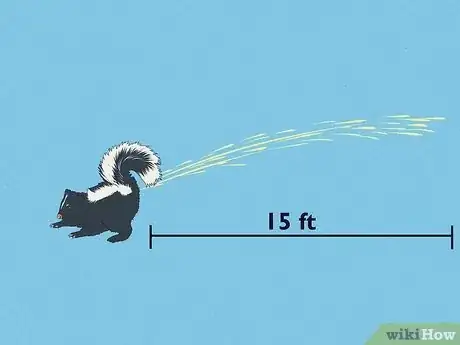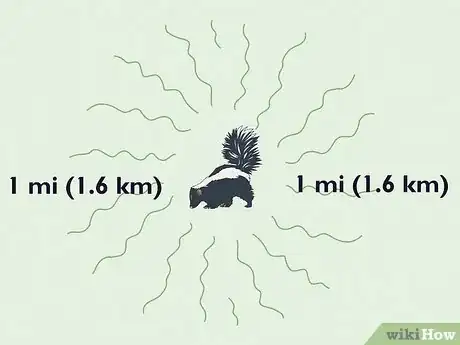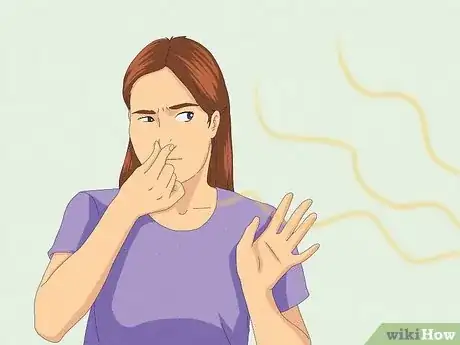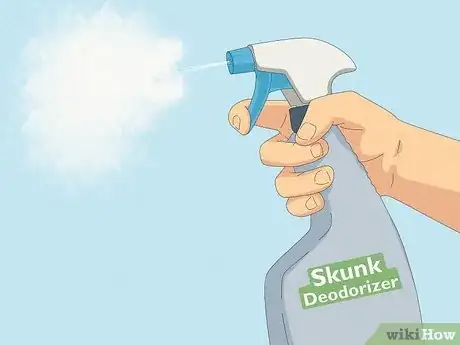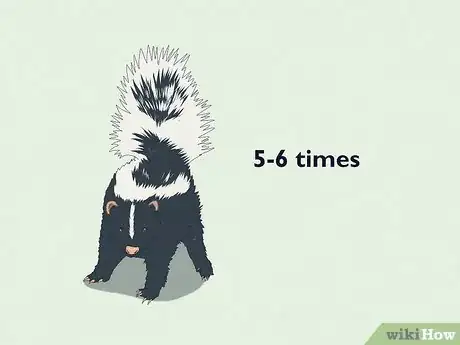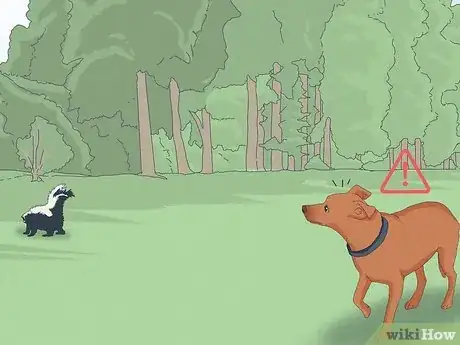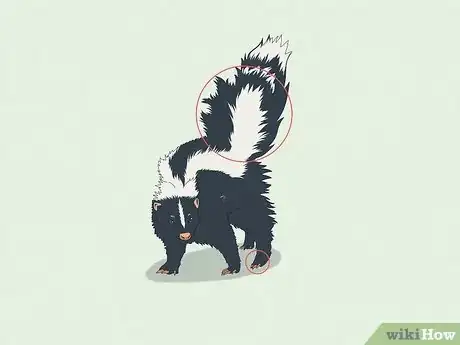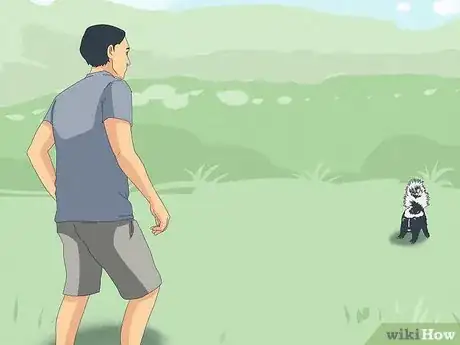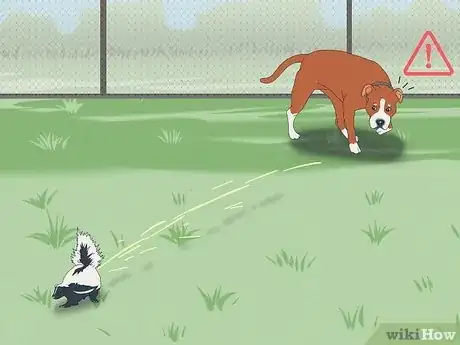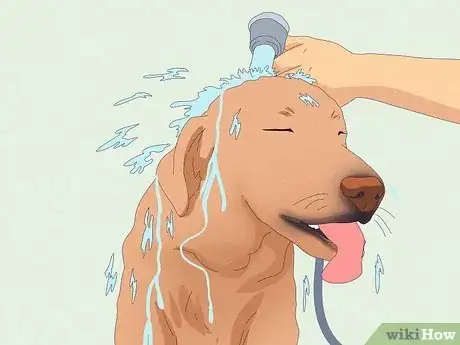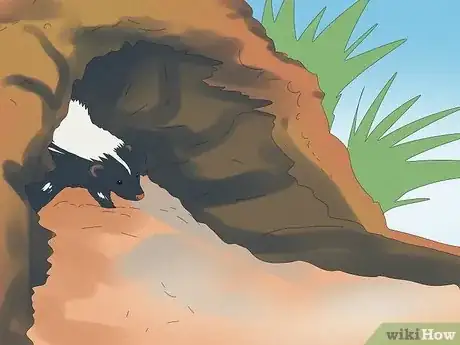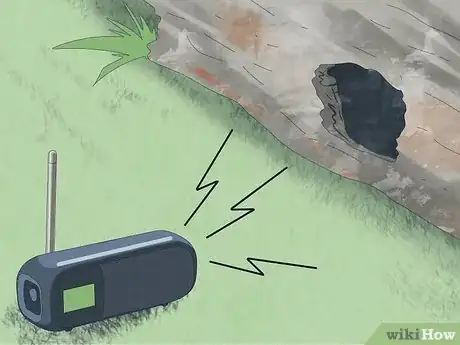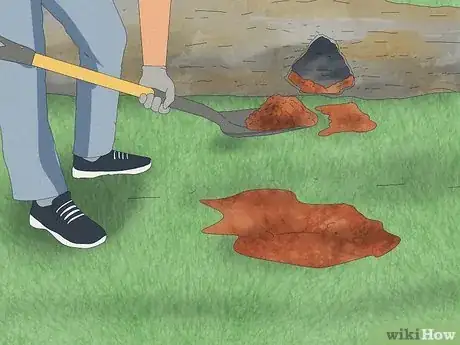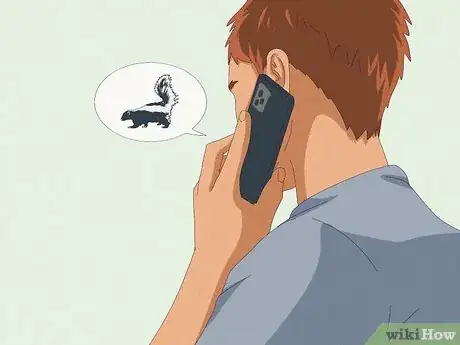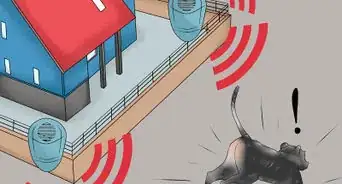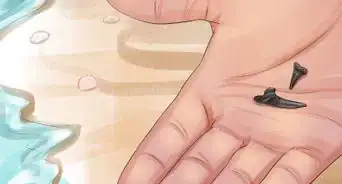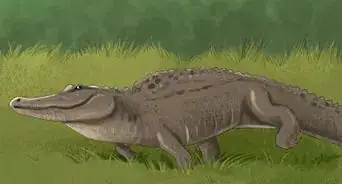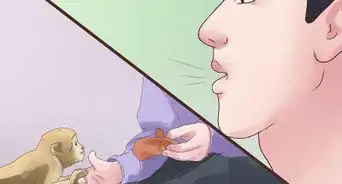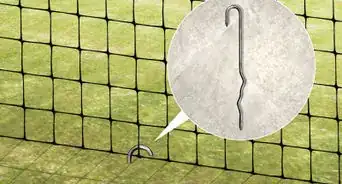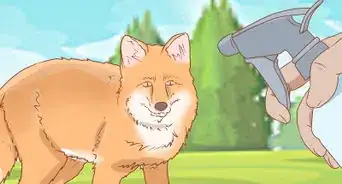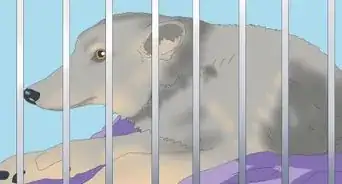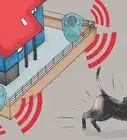This article was written by Chris Parker and by wikiHow staff writer, Danielle Blinka, MA, MPA. Chris Parker is the Founder of Parker Eco Pest Control, a sustainable pest control service in Seattle, Washington. With over seven years of experience, Chris specializes in Integrated Pest Management and doesn’t use any chemicals for pest removal. He offers removal services for ants, rodents, fleas, spiders, wasps, and more. Chris is a certified Commercial Pesticide Applicator in Washington State and received his bachelor’s from the University of Washington.
There are 8 references cited in this article, which can be found at the bottom of the page.
This article has been viewed 3,672 times.
When you find yourself in a standoff with a skunk, there’s one question on your mind. How far can that skunk spray? We'll answer this question for you and so much more. From skunk baths, to avoiding skunk spray, to ridding your home of the smelly little critters for good—read on for everything you need to know. Next time you encounter one of these furry stink bombs, you’ll be ready.
This article is based on an interview with our certified commercial pesticide applicator pest control specialist, Chris Parker. Check out the full interview here.
Things You Should Know
- Most skunks can accurately spray from about 15 ft (4.6 m) away.
- Skunk spray can travel very far when it’s windy, so you might smell it up to 1 mi (1.6 km) away.
- Skunks can only spray about 5 to 6 times in a row, and their spray is their only defense against predators, so they don’t want to spray you.
- A skunk will only spray you if it feels threatened, so quietly walk away from a skunk if you encounter one in the wild.
Steps
Avoiding Skunk Spray
-
1Pay attention to the warning skunk's give before they spray. Skunks want to save their spray because it takes time to replenish it. In the meantime, they’re in danger from possible predators. To give you time to retreat, they’ll stomp their little feet, arch their back, and lift their tail. You might also hear a high-pitched screeching sound.[10]
- Skunks stomp both of their front feet at the same time, and it sounds like a “tap, tap, tap.” You might also hear grass or leaves crunching.
-
2Leave the skunk alone. It’s very unlikely that a skunk will spray you, unless it feels threatened. If you see a skunk, do your best to stay quiet and slow down so the skunk knows you’re not a threat. Then, move slowly away from it so it’s less likely to react.
- Skunks are afraid of loud noises, so be as quiet as possible.
Dogs & Skunk Spray
-
1Dogs scare skunks, so they’re more prone to getting sprayed. Your pup is everything a skunk hates. Dogs are a larger animal, and their barks and growls are noisy. Worse, your dog is likely going to want to meet the skunk—and might even mistake it for a toy. A skunk will spray your dog if it’s afraid.[11]
- Even the friendliest dogs can lunge at skunks. Tell your dog to “heel” or “stay” to stop it from lunging.
- Before your pup goes out to pee, turn on your outdoor lights and wait a minute. Skunks hate bright lights, so they might skedaddle before encountering your dog. [12]
- While you should be quiet if you see a skunk, being loud gives them time to run and hide before you meet. If you're walking your dog in wooded areas, make some noise![13]
- Skunk spray may cause eye irritation, but it won't cause any lasting harm to your dog.
-
2Give your pup a skunk bath to get rid of the odor. Use a skunk shampoo that’s formulated for dogs or make one yourself. It’s safe to use the odor neutralizer we mentioned earlier on your dog. Once you give your pup a quick bath, their smell will improve a ton.[14]
- To make the odor neutralizer, you mix 1 qt (950 mL) of 3% hydrogen peroxide, 1/4 cup (45 g) of baking soda, and 1 to 2 tsp (4.9 to 9.9 mL) of liquid dish soap in an open container. Use the solution immediately.
Getting Rid of Skunks
-
1Remove trash and pet food because they attract skunks. Skunks are a lot like raccoons. They love to munch on your trash and steal your pet’s kibble. It’s time to cut off the all-you-can-eat critter buffet outside your home. Start securing your trash can lid to make sure the skunks can’t get inside. Additionally, feed your pets inside or pick up uneaten food after a few minutes.[15]
- Skunks also dig up bugs to eat, so treat your yard for pests if the skunks don’t go away.[16]
- Once the skunks realize their food source is gone, they’ll mosey on over to someone else’s trash heap.
-
2Look for skunk activity under buildings, wood piles, or the ground. Skunks are nocturnal and prefer to live in cramped, dark places. They usually don’t make their own burrows, so they live under homes or sheds, under wood piles, or in other animals’ abandoned burrows. Look for skunks under the buildings on your property.[17]
- If you can smell skunks but not see them, follow your nose to see if it leads you to a skunk hidey hole.
-
3Annoy the skunk with lights and noise until it leaves. Skunks really want to be left alone, so they’ll up and move if you’re bothering them. Use noise and flashing bright lights to irritate the skunk. During the day, shine a flashlight into the skunk’s hidey hole periodically. Additionally, set a radio next to the hole because the sound will bother the skunk.[18]
- After a few days of your harassment, the skunk will likely move out to pursue a more peaceful home.
- It’s best to leave the skunk alone during late spring or summer. That’s when skunks have babies, and they need their mother. If you evict the momma skunk, the babies will die. Oh, the smell!
-
4Make sure the skunk is gone before you seal off their hidey hole. Stuff newspaper into all of the open spaces around the skunk’s home. Check the newspaper daily to see if it looks moved. If it’s been disturbed, your skunk is likely still living in its hidey hole. If the paper is still in place, congrats! Your skunk is officially evicted![19]
- Keep stuffing the paper into the holes until your skunk is gone.
-
5Cover and seal all openings around your home's foundation. Skunks love to live under homes and sheds because they’re very cozy. They’ll make themselves right at home under your porch or under your back stairs. Eliminate their hidey holes by covering them with mesh, wood, plastic, or concrete.[20]
- For a decorative option, install some lattice work around the base of your home.
-
6Call a local wildlife pest control operator if the skunk won’t leave. Don’t try to trap a skunk yourself because that’s a recipe for a big, stinky disaster. You’ll likely get sprayed, as will your home. Plus, you can’t legally dispose of a skunk in most areas. Play it safe by calling in an expert pest control operator.[21]
- Once the skunk is gone, remember to seal off those entryways so another one doesn’t move in.
Warnings
- Although skunk spray isn’t dangerous, it is an eye irritant.[25]⧼thumbs_response⧽
- In many areas, it’s illegal to trap or kill a skunk unless you have a trapper’s license.⧼thumbs_response⧽
References
- ↑ https://wildlife.unl.edu/pdfs/removing-skunk-odor.pdf
- ↑ https://www.esf.edu/aec/adks/mammals/striped_skunk.htm
- ↑ https://www.iowadnr.gov/About-DNR/DNR-News-Releases/ArticleID/1699/Cool-things-you-should-know-about-skunks-yes-skunks
- ↑ https://wildlife.unl.edu/pdfs/removing-skunk-odor.pdf
- ↑ https://wildlife.unl.edu/pdfs/removing-skunk-odor.pdf
- ↑ https://wildlife.unl.edu/pdfs/removing-skunk-odor.pdf
- ↑ https://www.esf.edu/aec/adks/mammals/striped_skunk.htm
- ↑ https://www.iowadnr.gov/About-DNR/DNR-News-Releases/ArticleID/1699/Cool-things-you-should-know-about-skunks-yes-skunks
- ↑ https://www.esf.edu/aec/adks/mammals/striped_skunk.htm
- ↑ https://extension.psu.edu/skunks-solutions-to-common-problems
- ↑ https://www.wildlifecenter.org/skunks-neighbors
- ↑ https://www.mass.gov/service-details/learn-about-skunks
- ↑ https://www.wildlifecenter.org/skunks-neighbors
- ↑ http://ipm.ucanr.edu/PMG/PESTNOTES/pn74118.html
- ↑ https://extension.psu.edu/skunks-solutions-to-common-problems
- ↑ https://www.esf.edu/aec/adks/mammals/striped_skunk.htm
- ↑ https://www.esf.edu/aec/adks/mammals/striped_skunk.htm
- ↑ https://www.esf.edu/aec/adks/mammals/striped_skunk.htm
- ↑ https://www.wildlifecenter.org/skunks-neighbors
- ↑ https://extension.psu.edu/skunks-solutions-to-common-problems
- ↑ https://extension.psu.edu/skunks-solutions-to-common-problems
- ↑ https://www.iowadnr.gov/About-DNR/DNR-News-Releases/ArticleID/1699/Cool-things-you-should-know-about-skunks-yes-skunks
- ↑ https://health.frederickcountymd.gov/370/Human-Exposure
- ↑ https://wildlife.unl.edu/pdfs/removing-skunk-odor.pdf
- ↑ https://www.esf.edu/aec/adks/mammals/striped_skunk.htm
